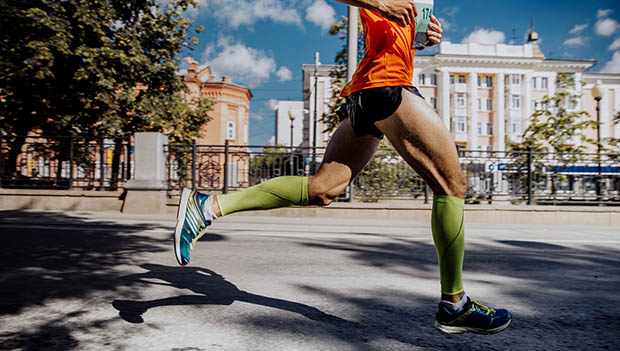
The revival of spandex and knee-high socks isn't to make a bold fashion statement. Believe it or not, it's to boost your fitness health.
There's been conversation for years about whether compression wear is beneficial to gym-goers. New research shows there's a great deal of health benefits when you wear compression garments that goes beyond just working out.
"We discovered there are many health benefits when one wears compression garments—and it goes beyond medical needs," Hermann Meyer, Doctor of Sports Science, says.
From increasing energy and setting a PR to injury prevention and fatigue reduction, compression wear can help you feel good and reach your goals. Here's why you may want to consider wearing something with compression for your next workout and beyond.
Less Vibration
Your body jiggles no matter what type of movement you perform. Some vibration is more intense depending on the surface on which you run or walk. If you are on soft surfaces, such as grass or dirt paths, you may not jiggle as much. But if you're on hard pavement, your muscles work a little harder, which will produce a bigger shockwave that travels up your muscular system.
The more your muscles deal with vibration, the more lactic acid is built up and the more prone they are to injury. "Compression garments help minimize the vibration, which helps decrease the chances of injury," Meyer says.
More Energy—Less Leg Fatigue
During and after a workout, your body can get tired. Meyer found during his study that those who wore compression during and after physical activity experience less leg fatigue than those who didn't wear any compression socks or sleeves. Because blood is circulated while wearing compression and individuals who wore compression didn't experience as much vibration—causing muscles to be overworked—individuals seemed to have more energy, could perform better and didn't tire as quickly.
Less Inflammation
Compression helps constrict the muscle which in tern reduces the amount of fluid that can build up. "When we work out, especially during a tough workout, our muscle get inflamed," Meyer says. We get an increase in fluid of the area we worked, which leads to swelling and can sometimes lead to pain.
Less Soreness
If you haven't worked out in a while or are training a new muscle group, there's a good chance you'll experience some soreness. However, when you wear compression during a workout, you help circulate blood flow, which eases lactic acid buildup and reduces delayed onset muscle soreness (DOMS). Wearing compression after a workout helps get the blood flow moving so lactic acid doesn't set in, which again reduces the chances of DOMS.
Beyond the Gym
Whether standing or sitting for long periods of time or even when traveling, wearing compression materials can help increase energy and reduce inflammation by helping increase blood flow."Long-distance travel causes an increase in leg volume by at least three percent," Meyer says. "The inflammation is correlated with pain, tiredness and a decrease in movement." Because compression helps blood circulation and constricts the amount of fluid buildup, it's ideal to wear when traveling.
During Meyer's study, subjects who wore compression didn't experience as much swelling compared to those who didn't.. Individuals also said they didn't experience tired legs or discomfort, unlike those who didn't wear compression.
Meyer recommends wearing a lower-leg compression sock, like the CEP Recovery Sock if traveling for less than 60 minutes. If your trip is expected to last longer than an hour, a full-leg compression garment is ideal, like the CEP Recovery Pro Tight.
Meyer saw an 89-percent positive effect on individuals' recovery and performance when wearing compression during travel, sitting or standing for long periods and during physical activity.
The bottom line? Compression gear has its benefits. If you want to optimize not only your recovery but your training as well, look into using compression during and after workouts.
READ THIS NEXT: Compression Gear: Help or Hype?


